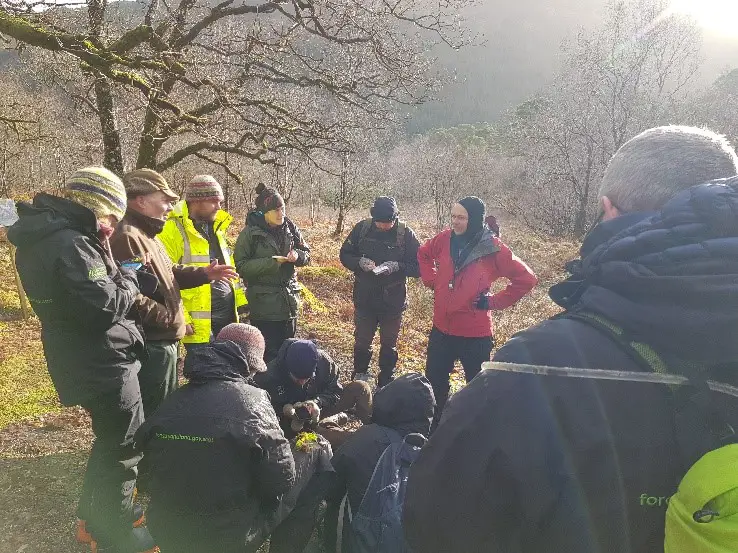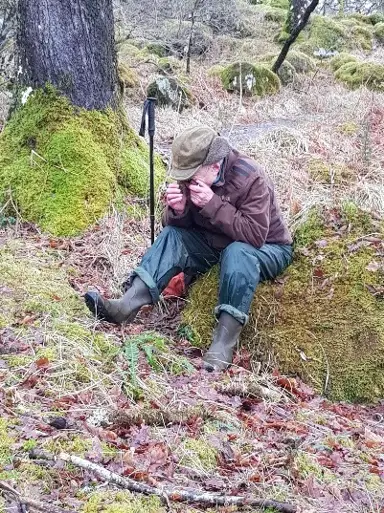Lichen, moss or grass: rainforest adventures with Plantlife

Guest blog by our native woodland ecologist, Richard Thompson, on a recent training tour of Scotland’s rainforest.
Thirteen of our staff gathered around Plantlife’s Lichen and Bryophyte Advisor, Oliver Moore, to learn about the lichens, mosses and liverworts that make Scotland’s rainforests such special places.
We were in the heart of rainforest country, at the head of Loch Sunart in Ardnamurchan. A landscape bedecked in oak and birchwoods, encrusted with mosaics of colourful lichens and hanging with curtains of moss.
The workshop got off to a cracking start as thunder rumbled loudly over the Ariundle Centre. This was soon joined by large bouncing hail stones. Fortunately, to get us started, Oliver had prepared an exercise out of harm’s way. Which is the odd one out? Lichen, seaweed, fern, moss or grass?
There are a couple of right answers. We listened with interest to the explanations and learned lots as the hail subsided and the wind died down.
Day one was dedicated to mosses and liverworts, collectively termed bryophytes. For the uninitiated, a whole day looking at variations on a theme of green might sound excruciatingly dull. But, not so! Particularly given Oliver’s infectious enthusiasm, the interest of the group and the treasure trove of species all around us. Oliver took us to the heart of Ariundle National Nature Reserve, managed by NatureScot and within a FLS forest that is managed in part for PAWS [planted ancient woodland sites] and peatland restoration. This is a remote part of Scotland and where we began to understand it takes a lot of nerve to be a moss!
Oliver explained some of the differences between mosses and liverworts including that a fine, dark nerve (or ‘costa’) can be found (with a little patience) in the leaf of some mosses but not in the leaf of any liverworts. How on earth could we see such detail you might ask. Everyone was armed with a x10 hand lens (a small magnifying glass) that allowed us to see incredible detail as we worked our way through the field guide key to successfully identify the splendid ‘glittering wood moss’.

We were then asked to select a moss, look at its features and give it a name. There were some great imaginations at work as “Baby’s fingers” and “Pterodactyl Claw” were described – a fun, daft exercise that got us looking carefully, describing the detail and noticing big differences between species that might at first have seemed almost identical.
In the afternoon, we started looking at some rainforest specialists as we headed up into the oakwoods amongst huge boulders. The first was the Atlantic featherwort – a rare species confined to the best ancient rainforest and usually found on the south east side of boulders and rock outcrops – but here, where conditions were so perfect, we found it growing up to head height covering the whole bole of an old birch tree. More ubiquitous rainforest species were also seen, including the western earwort (a messy, olive coloured liverwort, often on the base of trees or on boulders), prickly featherwort (a species with conspicuously toothed, translucent leaves) and greater whipwort – a beautiful hooded liverwort with three lobes to every sculpted leaf.
Apart from the odd brief soaking, the weather had been kind to us. A brisk walk back to the comforts of the Ariundle Centre and the day was rounded off (after a much-needed cuppa and lemon drizzle cake!) with a closer look at collected samples under binocular microscopes. Callum was the leading swot and successfully identified several species by carefully working through keys and descriptions. There was a lot of interest from everyone and much time was spent carefully examining a range of contrasting species.
Day two began at An Cnap, an area of ancient upland oakwood close to Salen village, a few miles west of Strontian and further down the Ardnamurchan peninsula. We were joined by Izzy Baker, local manager for the RSPB. This woodland has been deer fenced for the last 20 years and has a quite different character to Ariundle – with knee high heather, tall hard fern and more competitive bryophytes. There are young rowan, holly and hazel saplings as well as a large number of old holly trees.
We had barely made it out of the car park when Oliver sprang into action and drew our attention to an oak sapling, covered in striking leafy rainforest lichens. Simon Smith had clearly been doing his homework and went to the top of the class with his technical definition of a lichen. Oliver described the symbiotic relationship between the fungal part of these organisms and their green algae or cyanobacteria partners. Such is the diversity of these rainforests that he merely had to move to the next tree to find another species to illustrate his point.
We looked at the Lobarion community on the nutrient rich bark of rowan, willows and some oaks – big leafy species as well as ‘shingles’ of dark grey scales, some with orange ‘jam tart’ like fruits. Oliver described the abundance of these species where we stood compared to elsewhere in the west of the UK, one tree being covered in the equivalent amount to that in a large wood elsewhere.
We then looked at the Parmelion community on more acidic bark of birches and other oaks. These are typically blue/grey and can be trickier to identify. Oliver pointed out that some of the root like ‘rhizines’ on the lower side of the leaves were branched and some were simple.
Lichens can reproduce (through spores) or vegetatively (e.g. by fragments of leaves being carried by wind or on the body of slugs and snails). We were shown the tiny peg-like structures (isidia) on some species and floury or granular structures (soredia) on others – both involved in vegetative reproduction.

As we walked into the wood some time was spent looking at the profusion of ‘black-eyed Susan’ a beautiful shrubby species of lichen which is restricted to the best rainforests and even there, is rarely abundant. We looked up at this species from the base of an old oak and saw the hundreds of black spore covered fruiting bodies protruding at angles like curious periscopes.
Oliver then pointed out a grey-green crusty species growing on many of the oaks. This is one species of ‘cudbear’ lichen, used to dye wool a strong red colour. He sent scouts off to look for its rarer close relative and eagle-eyed Finbarr soon located some - this version with smooth margins to the fruiting bodies. The second species was used to create an imperial purple dye.
We passed old birches and were shown the flute lichen – an old woodland indicator with tiny round holes in the leaves like finger holes on the eponymous instrument.
The terminus of our walk was a collection of hazels, some old and coated in a great diversity of Lobarion species – some of which smelled of old rotten fish (we were having a great time, honestly!) and some of TCP ointment. The younger smooth hazel stems supported the dots and squiggles of the Graphidion community – some, as found by John, formed big, bright orange patches with large black dots (yet another type of fruiting body).

All in all, we all had a couple of excellent days, learned a huge amount and enjoyed the wonderful woods around Loch Sunart.
Our thanks to the Ariundle Centre for looking after us so well, to Callum for organising the event and most of all to Oliver for enriching our understanding of these important habitats, teaching us how to identify a wide range of species and passing on his enthusiasm for these special plants and lichens.
So, which is the odd one out? Lichen, seaweed, fern, moss or grass? Well, you’ll just have to attend one of Oliver’s workshops to find out!